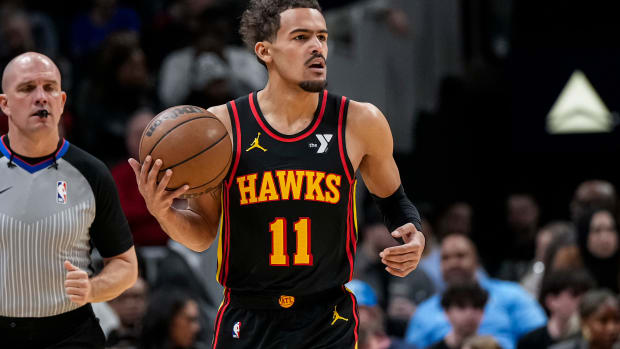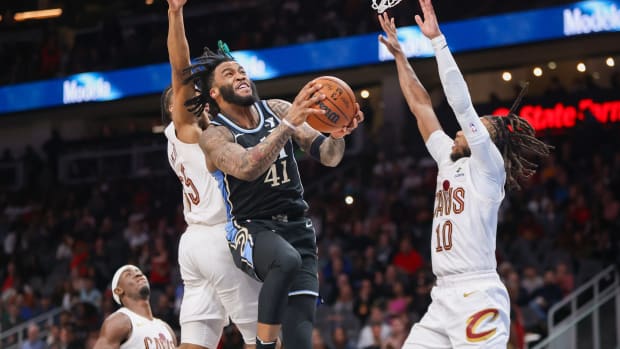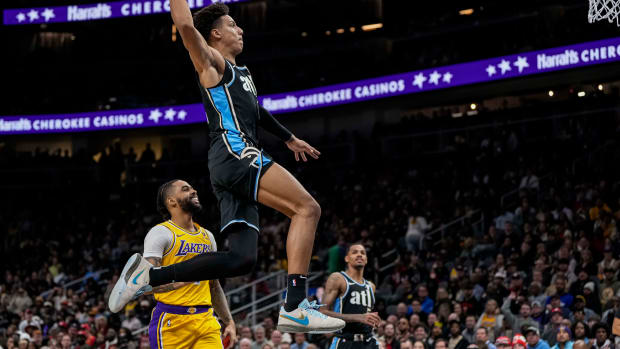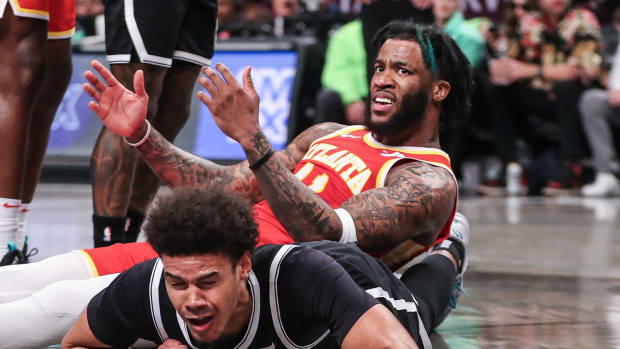Three-Point Play: Reddish & Young Lift Hawks To Win Over Spurs
The heroes of Atlanta’s Friday-night win over the Spurs weren’t alive on February 15, 1997 – the last time the Hawks won in San Antonio. Kevin Huerter, who hit the go-ahead 3-pointer with six seconds to play, was born 18 months after that game; Trae Young, who spearheaded Atlanta’s attack, came along a month after that and John Collins, Atlanta’s rock on the interior, was born in September of ’97.
Steve Smith led the Hawks in scoring that night against a team that hadn’t yet drafted Tim Duncan and featured a 37-year-old Dominique Wilkins in the starting five. In 21 tries since then, victory eluded Atlanta in that city. What makes it all the more staggering that this year’s Hawks, now owners of a 10-32 record, could be the team to end that streak. The Spurs are weaker than they have been at any point since 1998, but Atlanta has been the worst team in the NBA for most of the season and played shorthanded on Friday night.
The Hawks erased a 15-point deficit in the second half, weathering a 41-21 third-quarter onslaught before outscoring Antonio 33-21 in the fourth quarter. Earlier in the season, Atlanta might have let that deficit grow into a blowout loss, but on Friday the Hawks showed a mental resolve that has become increasingly evident in recent weeks. Lloyd Pierce rode the second unit as long as he could in the middle of the second half before the starters closed it out, and Atlanta received important contributions from nearly everyone who took the floor.
“That’s a lot of growth out there tonight,” Pierce said after the game. “Just the way they competed, the way they got down and came back, and it was fully a team effort.”
LaMarcus Aldridge poured in 30 points for the Spurs, but was limited by foul trouble and eventually fouled out with just over a minute remaining. Without its offensive fulcrum, San Antonio failed to generate an open shot on its final possession, and the Hawks escaped with a 121-120 victory.
Here’s what stood out from the win:
Trae Young’s Gravity
Young was masterful in 35 minutes of work and finished with 31 points and nine assists on 10-of-16 shooting. He drilled six of his nine 3-point tries and turned the ball over just three times – a reasonable number given his heavy offensive burden. But his effect on the other nine players on the floor stood out just as much as his individual production. Young averages over 21 field goal attempts per game but needed only 16 to top his scoring average on Friday, and Atlanta efficiently distributed those remaining five shots to other players for a healthier, more dynamic offense. The Hawks scored 1.15 points per possession on Friday, shot 11-of-13 at the rim, and hit 19 of their 40 attempts from deep. Some of those made buckets were from Young himself, but far more were a product of his passing, movement, and gravity.
Atlanta’s pick-and-roll gave San Antonio fits from the start of the game. Young had three assists in the first quarter alone, finding open shooters and roll men headed toward the rim:
The Spurs adjusted their pick-and-roll coverage to take away those lobs and dropped farther back against ball screens, so Young stepped into wide-open jumpers:
Eventually, the Spurs started putting two defenders on the ball, which only created looks for other Hawks:
Atlanta began using its guards as screeners, who had plenty of space to shoot when their defenders chased Young:
Perhaps no play better demonstrated the pull Young has on a defense than the Hawks’ final bucket – a go-ahead 3 on which he registered neither a field-goal attempt nor an assist. Atlanta ran a high ball screen on the right side of the floor between Young and De’Andre Hunter while Collins slipped toward the weak side. Young drew two defenders, which created a three-on-two for Atlanta, and Hunter made the correct read to find Huerter in the corner:
Neither Young nor Collins will officially receive credit on that play, but they were as integral to its success as anyone. “This is what we’ve talked about all year – the extra attention that Trae will receive,” Pierce said. “It starts with just understanding this is how teams play Trae, and his ability to get off the basketball and get it to an open man, we end up with a corner 3 with our 40 percent shooter.”
Cam Reddish, Gradually Coming Along
One of the most fascinating storylines of Atlanta’s season has been Cam Reddish’s progression as a defender and decision-maker. The 20-year-old entered the NBA with almost literally no clue what he was doing. He was thrust into a role that asked far too much of him and figuring everything out on the fly. The Hawks knew this, but threw him into the fire anyway. He would charge into crowds with no backup plan, try to beat defenders with individual moves he hadn’t mastered, and brick wide-open jumpers opponents invited him to take.
On most nights, Reddish is still an offensive liability, but he’s no longer the worst rotation player in the NBA. He’s already Atlanta’s best on-ball defender and has slowly begun to play with more restraint on offense. The rookie played perhaps his best game as a pro on Friday, finishing with 22 points, five rebounds, four assists, and four steals on an efficient 8-of-13 shooting line. He darted around on defense while making (mostly) sound decisions on the other end, and was the Hawks’ only reliable source of offense during their third-quarter dry spell.
“The shots went down,” Pierce said. “And when the ball goes in the basket he’s going to keep attacking and keep trying to make plays. His confidence hasn’t wavered one bit. Not one bit. And so to see it go down and see the work that he’s been putting in, you applaud him for the effort he had tonight. But he just stayed confident, he stayed aggressive from start to finish really.”
He didn’t second-guess shots, but rather stepped confidently into them. Save for a bad turnover in the fourth quarter, he played under control with the ball in his hands (Reddish was whistled for a dubious offensive foul earlier in the period, but it was hardly a reckless play). The Hawks trusted him enough to handle the ball and make decisions, which he did capably:
That’s a simple pass, but simple and easy aren’t always synonymous for NBA rookies. It has taken Reddish time to consistently identify and execute simple plays; making basic reads and delivering timely, accurate passes is a step in the right direction. He remains an incredibly streaky shooter, prone to hot games like Friday’s and equally profound cold spells, but Reddish is shooting 40 percent from 3 in the month of January with a positive assist-to-turnover ratio.
Rookies seasons like Young, Luka Dončić, and Ja Morant’s can obscure the fact that progress typically happens slowly and that rookies need time to develop into useful NBA players. It has been fun watching Reddish toddle down the path toward becoming one.
Staggering Young/Huerter/Collins
Atlanta closed the third quarter and began the fourth on Friday with Young, Huerter, and Collins on the bench. I understand the rationale behind keeping those three tied together – Pierce wants to maximize the minutes with his best lineups on the floor, the trio has hardly shared the court all season, and Atlanta needs to develop its young players by playing them together.
I still think Pierce should stagger the three a little bit more. The last few games have featured long dry spells when those three hit the bench, and the Hawks simply don’t have enough offensive verve to make that arrangement tenable. Perhaps that changes as they integrate Jeff Teague into the rotation, though Teague is the kind of player who stabilizes a lineup rather than galvanizing it.
After the game, Pierce said he was pleased with the way the second unit kept Atlanta in the game, and while the bench didn’t score particularly well, it did manage to quell San Antonio’s offense for brief stretches and buy time for the starters on the front end of a back-to-back. “We struggled in that third quarter and we brought in a group from the bench, and we didn’t get the lead back, but that group settled the game,” he said.
It still feels like the Hawks need more punch on the second unit, and keeping Young, Huerter, and Collins on the bench at the same time is not the way to get it. Huerter’s all-around blend of shooting, playmaking, and on-ball defense would fit will in just about any lineup, and playing him more without Young could allow him more offensive freedom during certain pockets of the game. Collins and Young need each other to be at their best, but perhaps Atlanta tries to use the big man as a fulcrum in more Young-free minutes. Young is probably good enough on his own to keep the offense viable without the other two on the floor.
This is a difficult balance for a coach to achieve. Staggering minutes too heavily risks throwing players off their rhythm. Atlanta’s offense clicks with its three best players on the floor (who would have thought?), and the more Pierce staggers them, the less time he has to play them together. He might still be smart to lean slightly toward a more balanced approach.




